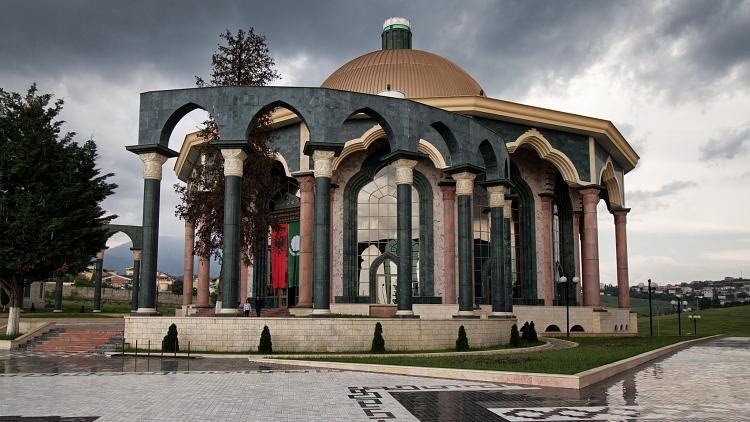
The religious-philosophical ideology Bektashism originated and spread first in Asia Minor. There it was associated with the names of religious and political figures, poets, and writers such as Bektashi Veli, Balim Sultan, Gul Baba and others. Bektashi doctrines are characterized by Shiite and pantheistic character, although the influence of Shiites may be relatively late (sixteenth century). It is also believed that the Bektashi combined in their Order a significant number of doctrines and practices of diverse origins, including not only Shiism and Sufism, but also preserved pre-Islamic and non-Islamic beliefs and customs originating from Christianity and ancient religions, as well as ancient Turkic elements. The Bektashi include anthropomorphic and Kabbalistic doctrines for the symbolism of letters and numbers that can be traced back to Hurufism, combined with an extremist Shiite credo that links devotion to Ali divinity with beliefs in anthropomorphism, the manifestation of God in human form, rebirth, and metempsychosis (the journey of the soul after death).
As a religious-political ideology, Bektashism was transmitted and spread in the Balkans, first in the lands of medieval Bulgaria, the main carriers and distributors of which were the Turkish alevis/allians (Kizilbashi), and then in Albania. There it played an important role not only in religious and cultural-historical terms, but also became an instrument for the formation of the Albanian national identity in the 19th and 20th centuries, as well as a basis for the development of Albanian literature and language. The activity and literary work of Naim Frasheri played a major role and had significance in these socio-political and cultural processes.
As one of the most prominent Albanian researchers on the subject, Professor Albert Doja, claims in his Bektashism in Albania: A Political History of a Religious Movement, heterodox religious movements, as in the case of mystical orders of Islam such as Bektashism, are crucial to understanding the history of religions in Southeast Europe. From the later development of Bektashism in the Ottoman Empire, it became clear that Albania often served as a kind of exile for adherents of the Bektashi faith, although their origins in Albania remain unclear. Being notably present in the second half of the 17th century, the Bektashi gradually became an increasingly important social stratum in Albania in the nineteenth century. According to Doja, one reason for this is the fact that the Bektashis were spared from the oppression that the Order had to face in Anatolia and other major areas of the Ottoman Empire during the first quarter of the nineteenth century (1822-1826). If the Janissary Army and the Bektashi Order were to be officially abolished in the Ottoman territories, the abolition could be effective only in the provinces where the central Ottoman administration had direct power. As Ottoman rule was insignificant in the Albanian areas during this period, the Bektashi continued to live undisturbed, in a much better and safer position than their counterparts in Turkey. Many high-ranking Bektashi, including sometimes even the supreme leader of the central institution, were often of Albanian descent. When Turkey ordered the final abolition of all mystical orders in 1925, the Bektashi headquarters again found refuge in Albania.
The Bektashi were active in the Albanian independence movement in the nineteenth century. Not only did they help the Albanian rebels fight the Turks, allowing them to use the Bektashi sacred places for hiding and secret meetings, but they also assisted in the distribution of Albanian books and newspapers in the Albanian lands. It is not clear whether the Bektashi took part in the Albanian uprisings in the 20th century, but their role was definitely important for the National Awakening (Rilindja Kombetare). One of the most significant Albanian authors and probably the greatest supporter of Albanian nationalism, Naim Frasheri, was also a member of the Bektashi Order. He tried purifying the Albanian language from Turkish words and initiated the use of Albanian as the official language of the Order. His “Fletorja e Bektashinjve” (The Bektashi Notebook) served as a guideline for the Albanian Bektashi.
According to Doja it is an exaggeration to say that Naim Frasheri’s experience aims to overcome the religious division of Albanians by proposing that Bektashism became a comprehensive national religion for all Albanians. Earlier information in the literature suggests that Naim Frasheri’s attempts were aimed at giving Bektashi an Albanian character. According to Albert Doja, the active promotion of the dualistic character and pantheistic concepts made it possible for Bektashism to join the Albanian national ideology.
Whether religious policy was a tool for mobilizing ideological myths or actual action, on the eve of Albanian independence, the Bektashi were numerically important and politically influential. Bektashism is often idealized as one of the incarnations of the Albanian popular spirit, which Bektashi leaders must have later used in deliberate instrumental politics to make Bektashi ideas attractive to non-Bektashis. According to Doja, heterodox mystics and heretics in different religions are often considered extreme or dangerous, and in other cases, depending on the political situation, could play an important role for a nation and its cultural and political development, as is the case with the Bektashism in Albania.
This article was originally published in Balkans in-site on November 29, 2021.
References
- Albert Doja. Bektashism in Albania: Political history of a Religious Movement. AIIS Press, pp.104, 2008, 978-99943-742-8-1. ffhalshs-01382774
- Robert Elsie. THE ALBANIAN BEKTASHI History and Culture of a Dervish Order in the Balkans, 2019
- https://kryegjyshataboterorebektashiane.org/en/home-2